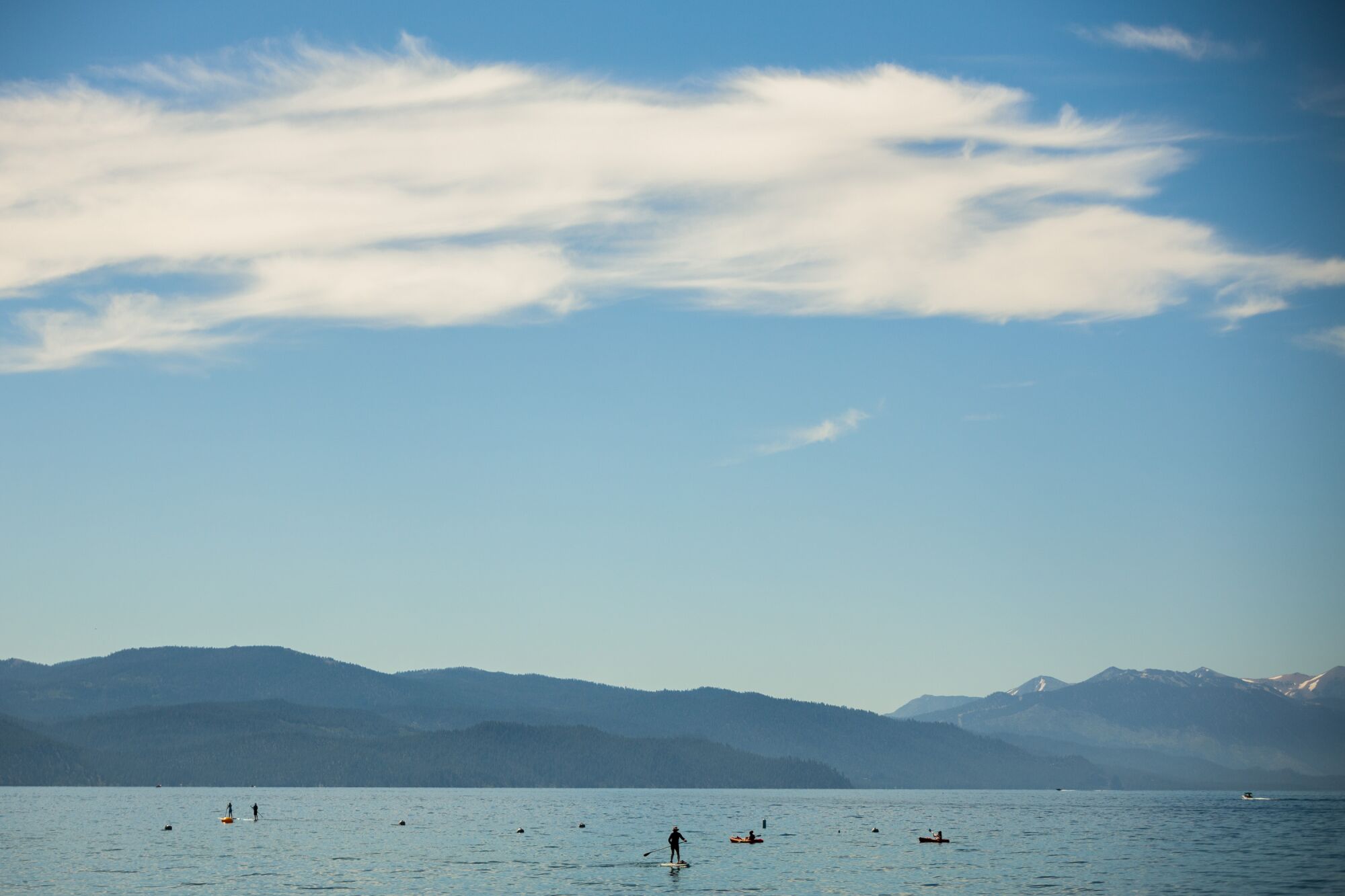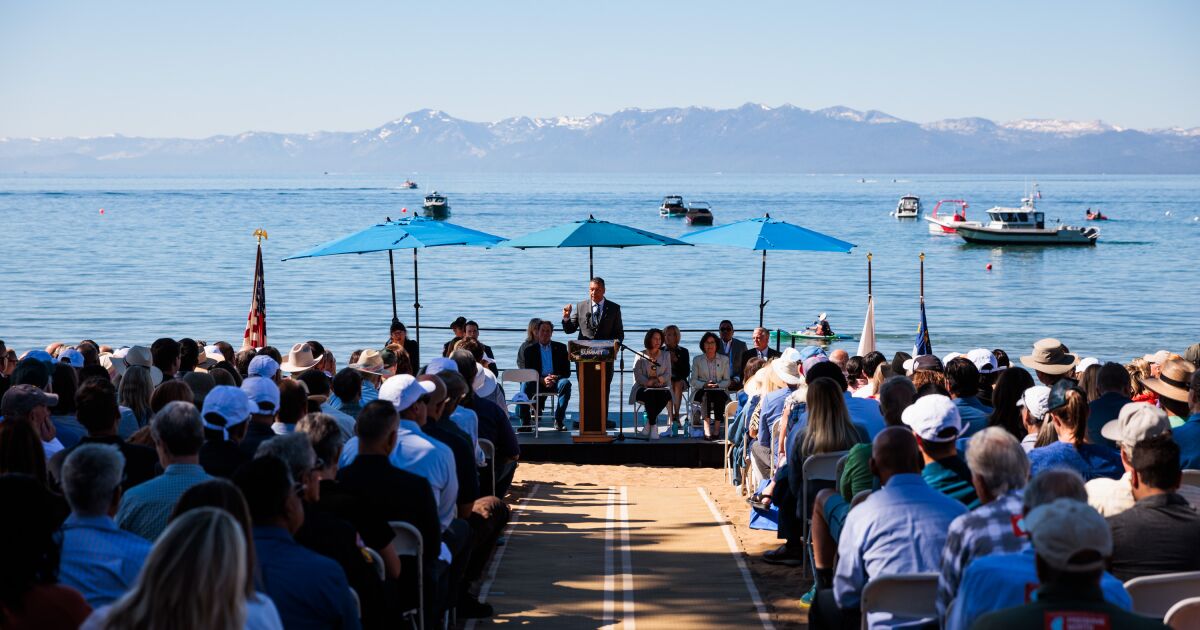Sen. Dianne Feinstein once spoke of a time 70 years ago when North America’s largest alpine lake was crystal clear and its air unspoiled.
As a 16-year-old, the San Francisco native fell for the region while at summer camp on the lake’s north shore and decades later built a vacation home near one of its many bays.
Part of her life’s work as a politician has been directing federal funding to preserving the gem on the California-Nevada border in the Sierra, where visitors flock by the millions to ski its mountain peaks, frolic in the lake and enjoy the natural splendor.
Central to the Democrat’s effort is the annual Lake Tahoe Summit, which she helped inaugurate in 1997 with former Senate Majority Leader Harry Reid (D-Nev.) and where Feinstein was honored Wednesday. The bipartisan gathering attracts the top leaders from California and Nevada and, on occasion, U.S. presidents to take stock of what was needed to keep the lake’s waters clear and fend off toxic algae.
“Tell them this: ‘I was a child in Lake Tahoe,’” Feinstein said in a text message read by former House Speaker Nancy Pelosi (D-San Francisco) on Wednesday. “‘I was an adult at Lake Tahoe. I am a senator for Lake Tahoe. And I’m determined that Lake Tahoe will survive.’”
Rep. Nancy Pelosi speaks at the Lake Tahoe Summit.
(Max Whittaker / For The Times)
Feinstein, 90, missed this year’s conference, which was hosted by Sen. Alex Padilla (D-Calif.), the state’s junior senator, another milestone in the slow transition of California’s top leadership to a new generation of rising politicians. Feinstein already announced plans to retire after her current term, following the venerable Sen. Barbara Boxer and Gov. Jerry Brown out of public office. Pelosi, who stepped down as speaker, has not announced her plans.
The inaugural Lake Tahoe Summit led to federal legislation and a near-yearly tradition in which politicians from Nevada and California descend on the mountain town and assess government efforts to keep the lake healthy, the drought-ravaged forests adequately maintained and the trails spotless. The conference has lead to almost $1.3 billion in funds being funneled to projects related to the lake.
Rep. John Garamendi (D-Walnut Grove), who served as deputy Interior secretary in the mid-1990s, recalled receiving a phone call from Feinstein.
“‘She finally said, ‘Hey, John, we’ve worked out a deal here. Harry Reid and I, we’ve got a deal going, and we’re going to need your help. We want to have a celebration,’” Garamendi told the crowed gathered on Tahoe’s northern shore. “About a week later, I got a call from the White House who said, ‘You need to figure out a big event at Tahoe, Reid and Feinstein are all over our back, and they want to celebrate this deal that they’ve put together.’”
Newsletter
The view from Sacramento
Sign up for the California Politics newsletter to get exclusive analysis from our reporters.
You may occasionally receive promotional content from the Los Angeles Times.
It was a measure of her relentless advocacy for the lake, he said as he looked at the glistening water behind him.
Still the work continues to preserve and protect the lake and surrounding forests, along with the tourism that sustains the region economically.
On Wednesday, Herman Fillmore of the Washoe Tribe offered a benediction celebrating land his people value so much, as three paddle boards languidly floated behind him, three people in kayaks passed by and three jet skis zoomed along in the distance. The scene was a coda for the displacement his people have experienced and the environmental destruction that’s occurred here as a result.
“We had newcomers to this place,” Fillmore translated at the end. “When they arrived, they cut down all of the trees and stole them. They dug up the ground. They took the gold and the silver that they were looking for, and because of that our forests and our lands and our waters are no longer clean and they’re sick. Today, our land is no longer good.”
This degradation was top of mind at this year’s conference. But it also focused on Feinstein’s legacy. Her health has been failing of late, and she hadn’t planned to attend this event because of the rigors of the travel involved.
Just this week she was briefly hospitalized after a minor fall in her home in San Francisco, according to a spokesperson for her office. This came on top of an extended absence from Washington this year as she recovered from a bout of shingles.
At Lake Tahoe’s Kings Beach on Wednesday, though, colleagues and admirers dwelt on her capacity to keep the lake’s restoration at the top of the federal government’s mind. The focus led to a visit from President Clinton and Vice President Al Gore at the first conference, as well as President Obama in 2016, and a renewed effort this year to extend the life of the Lake Tahoe Restoration Act.
Still, that infusion of capital hasn’t been enough.
Speaker after speaker at the conference mentioned a recent report revealing that the lake’s waters contain microplastic concentrations higher than those observed in ocean gyres — systems of ocean currents notorious for accumulating plastic waste.

Paddlers on Lake Tahoe during the Lake Tahoe Summit.
(Max Whittaker / For The Times)
The restoration act is set to expire next year. Elected officials from Nevada and California — Republican and Democrat — stated with confidence that the renewal, which would allow for the allocation of previously authorized federal funds, would pass Congress.
Though Feinstein is a sponsor of the bill, Nevada Democratic Sen. Catherine Cortez Masto has been leading the charge for renewal.
“It was Dianne and consistently has been Dianne, who believes in what we’re doing here around Lake Tahoe, and I just want to thank her, and of course, Sen. Reid, for starting this back in ‘97,” Cortez Masto told the audience of local environmental groups, government officials and advocates.
Cortez Masto, Garamendi and others said Feinstein would be as aggressive as ever to bring resources home.
The event ended with a recorded statement from Feinstein apologizing for missing the conference. She recalled riding her bike around the lake as a kid and lots of family vacations spent on its crystal clear waters.
“There’s no denying that Tahoe has been a very special place for me, just as it is for so many who call it home or visit its shores,” she said, her voice booming over loudspeakers. “That’s why I’ve made it my mission to preserve and protect this magical place from the many threats that it continues to face from overdevelopment, climate change, invasive species and wildfire, so that everyone can enjoy its wonders for generations to come.”
This story originally appeared on LA Times

